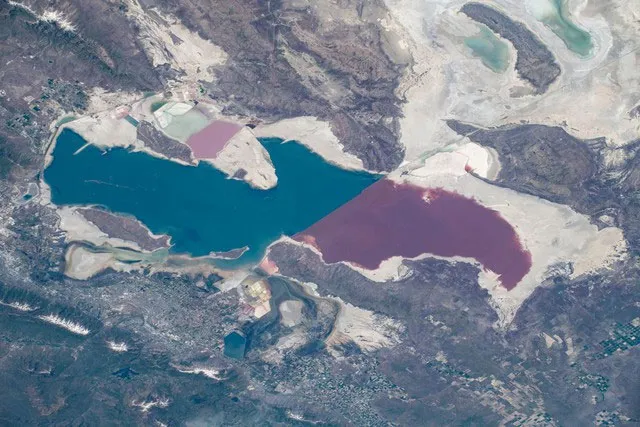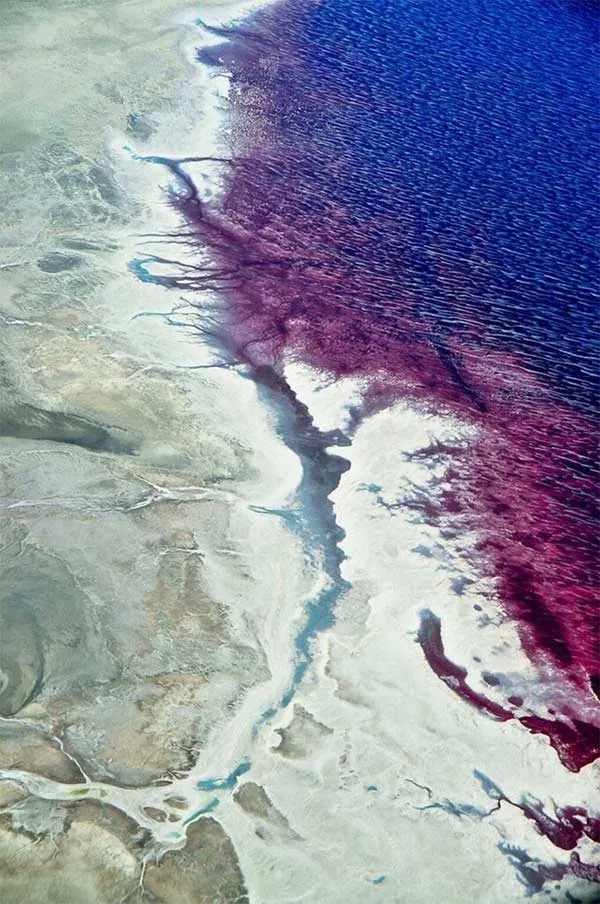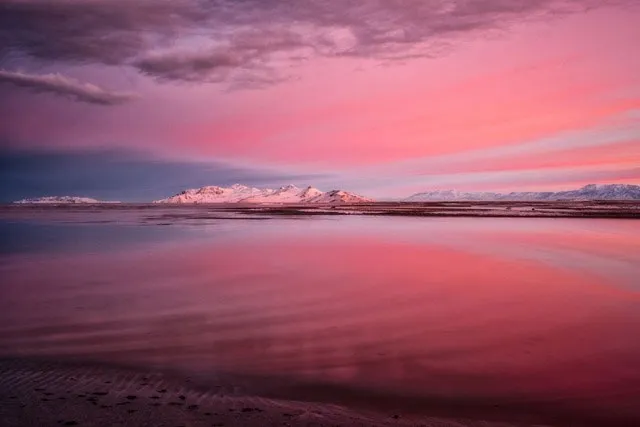Utah, a state famed for its majestic natural landscapes, offers not only fiery red rock canyons but also serene and enchanting emerald green lakes. These breathtaking lakes, with their unique hues, paint a picturesque natural masterpiece that attracts visitors from around the world. Join Travel Across the Globe as we explore these hidden gems in Utah and uncover the secrets behind their mesmerizing beauty.
The Ever-Changing Beauty of the Great Salt Lake
When talking about Utah, the Great Salt Lake is a must-mention, a natural wonder with immense size and salt reserves. What sets this lake apart is its extraordinary color phenomenon—one side showcases tranquil blue waters, while the other glows with vibrant red hues.

This color split is the result of a railway causeway called the Lucin Cutoff, constructed in the early 1900s. The railway inadvertently divided the lake into two sections, limiting water circulation and creating a distinct difference in salinity levels between the two sides.
A Magical Division of Colors
The southern section of the lake, which receives freshwater from rivers like Bear, Weber, and Jordan, has lower salt concentrations. Sunlight reflecting off the lakebed produces its signature emerald green hue. While the salinity isn’t high enough for Dunaliella salina algae to thrive, this region supports diverse microorganisms, contributing to its unique blue color.
In contrast, the northern section of the lake is more isolated, with salt concentrations nearly 10 times higher than those of the ocean. This extreme environment allows salt-loving organisms, particularly Dunaliella salina algae, to flourish. The red pigments within the algae create the striking crimson waters in the northern part of the lake. These colors can change with the season, becoming more intense during summer due to increased water evaporation.

Unique Ecosystem and Challenges
The Great Salt Lake serves as a habitat for many unique species, adapted to its harsh saline environment. Migratory birds and waterfowl frequently visit the wetlands surrounding the lake, which comprise approximately 75% of Utah’s wetland area.

However, this delicate ecosystem faces significant challenges, including environmental pollution, climate change, and over-extraction. Preserving the Great Salt Lake is critical to maintaining biodiversity and ensuring valuable natural resources for future generations.
Exploring the Great Salt Lake as a Tourist Destination
The Great Salt Lake is not only a natural wonder but also a favorite destination for tourists. Visitors can enjoy various activities like swimming, sunbathing, kayaking, and bird watching. Additionally, touring the region’s salt extraction facilities offers a fascinating insight into the area’s history and the salt production process.

Other Emerald Green Lakes in Utah
Beyond the Great Salt Lake, Utah is home to numerous other stunning emerald green lakes, offering diverse and enriching travel experiences.
Bear Lake
Located on the border between Utah and Idaho, Bear Lake is nicknamed the “Caribbean of the Rockies” for its crystal-clear emerald waters and pristine white beaches. This lake is ideal for water sports like swimming, paddleboarding, boating, and fishing. In winter, visitors can enjoy ice skating and snowmobiling across the frozen lake surface.
Panguitch Lake
Situated over 8,200 feet above sea level, Panguitch Lake is a haven for those seeking peace and tranquility. Renowned for its unspoiled beauty, emerald waters, and surrounding pine forests, this lake is perfect for fishing, hiking, camping, and enjoying the crisp mountain air.
Tibble Fork Reservoir
Nestled near the city of American Fork, Tibble Fork Reservoir is a favorite spot for outdoor recreation. With emerald green waters and stunning mountainous backdrops, it’s an ideal destination for photography, picnicking, and relaxation. Visitors can also indulge in activities like kayaking, fishing, and hiking around the lake.
Travel Tips for Exploring Utah’s Emerald Lakes
To ensure a memorable trip exploring Utah’s emerald green lakes, consider the following tips:
- Best Time to Visit: Summer (June to August) is the most favorable season to visit Utah’s lakes, with warm and pleasant weather. However, it’s recommended to book accommodations early due to peak tourist demand.
- Preparation: Pack sunscreen, hats, sunglasses, and comfortable clothing to protect against the sun. If you plan on engaging in water activities, bring swimwear and towels.
- Transportation: Renting a car is the most convenient way to explore the lakes in Utah. It offers the flexibility to reach different destinations at your own pace.
- Safety Considerations: Adhere to safety guidelines when participating in water activities. When swimming in the Great Salt Lake, bring a life jacket and avoid ingesting the lake’s salty water.
Conclusion
Utah’s emerald green lakes are precious natural jewels hidden amidst pristine wilderness. With their unique beauty and charm, these lakes promise unforgettable experiences for every traveler. Start planning your trip to Utah today and witness the miraculous allure of these emerald lakes firsthand.
Feel free to share your thoughts and experiences about Utah’s emerald lakes in the comments below!